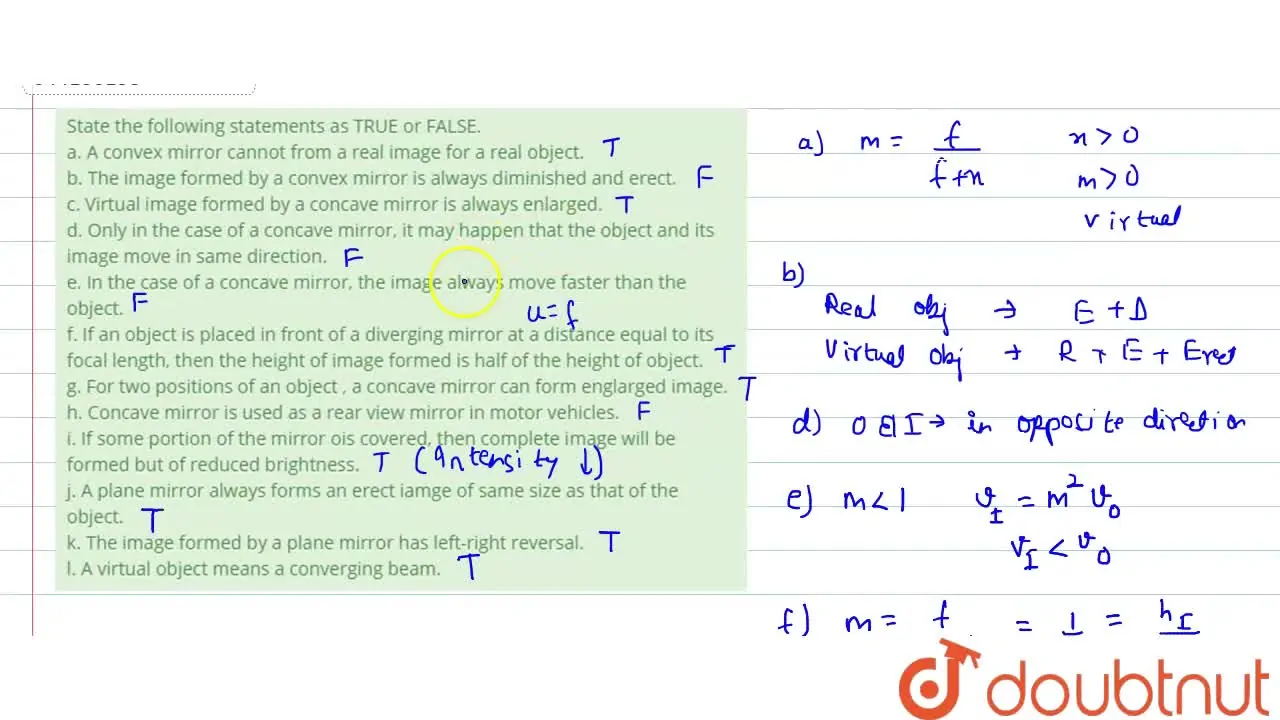State the following statements as TRUE or FALSE.
a. A convex mirror cannot from a real image for a real object.
b. The image formed by a convex mirror is always diminished and erect.
c. Virtual image formed by a concave mirror is always enlarged.
d. Only in the case of a concave mirror, it may happen that the object and its image move in same direction.
e. In the case of a concave mirror, the image always move faster than the object.
f. If an object is placed in front of a diverging mirror at a distance equal to its focal length, then the height of image formed is half of the height of object.
g. For two positions of an object , a concave mirror can form englarged image.
h. Concave mirror is used as a rear view mirror in motor vehicles.
i. If some portion of the mirror ois covered, then complete image will be formed but of reduced brightness.
j. A plane mirror always forms an erect iamge of same size as that of the object.
k. The image formed by a plane mirror has left-right reversal.
l. A virtual object means a converging beam.
a. True. According to the magnification formula,
m=f0f0+x
where x is distance of a real object. For all positive values of x, m is always positive.
b. False. For a real object , the image formed by a convex mirror is always erect and diminished.
m=f0f0+x
For a virtual object lying between pole and focus, the image formed is real, enlarged, and erect.
m=f0f0+x
c. True. For a concave mirror, we know that
m=f0f0+x
where x is the object distance.
If x<f0, then m>1 , which implies a virtual englarged image.
d. False. In case of mirrors (convex, concave, and plane), the object and its image always move in opposite directions.
That is, VU=−(fu−f)2
where V=velocity of image and U=velocity of object.
e. False. When the object is beyon the center of curvature, its image moves slower.
f. True. For a convex mirror, m=f0/f0+x
i.e., if x=f0, then m=1/2
g. True. A concave mirror forms an enlarged image in two situations:
i. Object is placed between C and F.
ii. Object is placed between F and P.
h. False. Convex mirror is used as a rear view mirror.
i. True. Complete image will be formed, but of less brightness because now the incident rays will be reflected from reduced area to form the image.
j. True, m=−v/u . For a plane mirror , v=−u
⇒m=+1. Hence, image is erect and of same size.
k. True . We see our left hand as right hand and right as left hand in a plane mirror.
l. True. Virtual object is that point where incident rays seem to be converging.
Related Playlists
- BOOK - CENGAGE PHYSICS ENGLISHCHAPTER - GEOMETRICAL OPTICSEXERCISE - Exercise1.325videos
GEOMETRICAL OPTICS
- BOOK - CENGAGE PHYSICS ENGLISHCHAPTER - GEOMETRICAL OPTICSEXERCISE - Exercise1.412videos
GEOMETRICAL OPTICS
- BOOK - CENGAGE PHYSICS ENGLISHCHAPTER - GEOMETRICAL OPTICSEXERCISE - Exercise1.114videos
GEOMETRICAL OPTICS
- BOOK - CENGAGE PHYSICS ENGLISHCHAPTER - ELECTRON,PHONTS,PHOTOELECTRIC EFFECT & X-RAYSEXERCISE - dpp 3.315videos
ELECTRON,PHONTS,PHOTOELECTRIC EFFECT & X-RAYS
- BOOK - CENGAGE PHYSICS ENGLISHCHAPTER - HEATING EFFECT OF CURRENTEXERCISE - Thermal Power in Resistance Connected in Circuit27videos
HEATING EFFECT OF CURRENT
Similar Questions
The image formed by a concave mirror
View SolutionThe image formed in a convex mirror is always erect and enlarged.
View SolutionImage of an object in a convex mirror is
View SolutionNature of image of a real object formed by convex mirror is always
View SolutionAssertion : A convex mirror can never make a real image
Reason : For all real objects image formed by a convex mirror is virtualView SolutionCan a convex mirror form a real image! Explain.
View SolutionThe image formed by a plane mirror is real. True/False
View SolutionThe image by a convex mirror is always formed in front of the mirror.
View SolutionFor what position of an object, a concave mirror forms a real image equal in size to the object?
View SolutionFor what position of an object, a concave mirror forms a real image equal in size to the object?
View Solution


